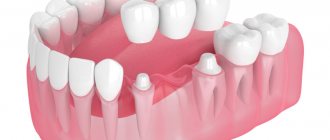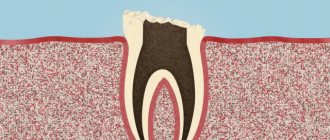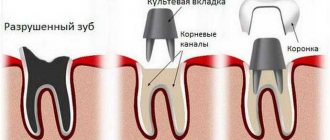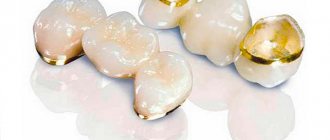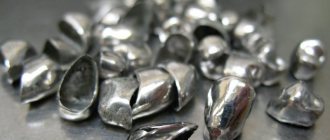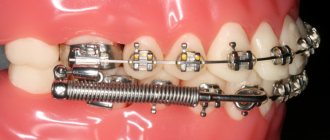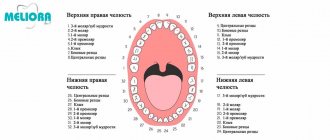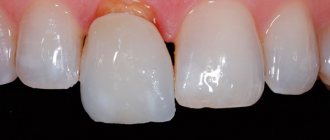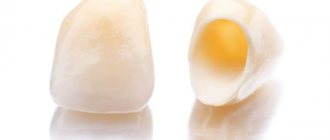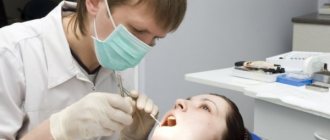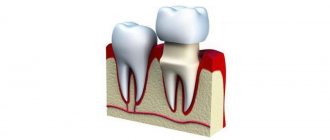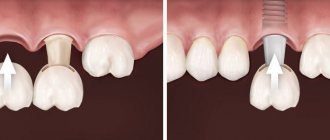Which dentures are better to put instead of chewing teeth - options, comparison, cost
Article navigation
- Functions of chewing teeth
- Prosthetic options
- — fixed dentures
- - removable dentures
- - conditionally removable
- Optimal methods of prosthetics
- The crown is destroyed, but the root is preserved
- One or more teeth are missing
- - bridges
- - removable structures
- - dentures on implants
- Installation
- How to care
- Price
Question for a specialist
Chewing teeth (premolars and molars) play a key role in the dental system and take on a greater load than the front ones.
At the same time, their anatomy and location make care difficult. That is why they are susceptible to destruction, mainly as a result of injuries due to chewing stress and dental diseases. Prosthetics of chewing teeth involves the use of various orthopedic structures and materials, the choice of which depends on the degree and location of the damage, as well as the patient’s requests. Next, we will talk about how chewing teeth are prosthetized and which prosthesis is better if they are missing.
Features of prosthetics on zygomatic implants
The entire treatment process takes a maximum of 2 weeks, but the prosthesis is placed immediately after implantation. This is an important feature, or rather, even a requirement of the protocol, which is dictated by both our own practice and the recommendations of implant manufacturers. The prosthesis must be fixed no later than 3 days after implantation. Firstly, it splints or stabilizes them, protecting them from displacement during chewing. Secondly, as soon as the patient begins to eat, the load is transferred to the bone through the prosthesis and then through the implants, normalization of nutrition processes between cells and faster tissue regeneration occurs.
When partially replacing chewing teeth, in 99% of cases the prosthesis is placed on the day of the visit, since the design is worked out in advance. This is a lightweight templated dental bridge, which is created from acrylic with the addition of monomers and diamond chips to improve strength characteristics and aesthetics. This prosthesis is very light and does not exert excessive pressure on the installed implants, which eliminates the possibility of them moving under chewing load.
More before and after examples
On average, after 2 weeks, after the so-called “critical moment” has passed, when we can say that the implants have reached a high level of primary stabilization and the risks of rejection are minimized, a model of a permanent prosthesis is developed. It has a metal base - a base that serves as a stabilizer for installed implants. At this stage, the recommended materials for the prosthesis are modern new generation plastic or ceramic composite.
Functions of chewing teeth and their characteristics
By chewing teeth of an adult we mean small chewing teeth - premolars ("four" and "five"), and large chewing teeth - molars ("six", "seven" and "eight"), which are located on the sides of each dentition. That is, both the lower and upper jaws have 10 chewing teeth, and in total there are 20 of them in the mouth - although there may be fewer of them if the “eights” have not erupted.
Molars and premolars perform the functions of a kind of “millstone”. Due to the protruding tubercles on their surface, they grind food so finely that it becomes suitable for further absorption by the body (and then enters the esophagus and stomach). Therefore, premolars and molars are very important for the normal functioning of the gastrointestinal tract and health in general.
Only until 30.09 South Korean implant Osstem - 19,900 rubles.
Hurry up to sign up for a free consultation and lock in promotional prices.
Call now or request a call
Opening hours: 24 hours a day - seven days a week
Premolars and molars experience very heavy loads, which can exceed 75 kilograms per square centimeter. Therefore, nature itself intended that they have massive dimensions (otherwise they would simply break from the pressure). But the service life of these teeth is seriously reduced by the presence of caries in the fissures (these are grooves between the tubercles), which gradually turns into pulpitis. And treatment of pulpitis is often complicated by a large number of roots (there can be up to 4 of them) and poor treatment of root canals, which can also be curved and difficult to pass.
Models and brands of implants
The Smile-at-Once clinic uses only original brands of implants and all suprastructures for them. For this protocol, we use products from Nobel, which was the first to produce zygomatic implants. Products of the same brand are used as a second support - usually the Parallel model. Like the cheekbones, they have a unique thread and an active TiUnit coating, which helps activate the growth of jaw bone cells, which significantly accelerates the process of tissue regeneration and allows for instant prosthetics without the risk of displacement of the installed structures.
Modern prosthetic options
What kind of prosthetics can a dentist offer if there are no chewing teeth? These can be different types of orthopedic structures - fixed, conditionally removable and classic removable dentures. Let us consider further their features for prosthetics of chewing teeth.
Fixed dentures
The most reliable method of prosthetics for the lower and upper chewing teeth are fixed dentures. Since they are fixed well, they do not fall out of the mouth, and their small size makes it easier to get used to and does not cause nausea or changes in the taste of food. Among the options for permanent prosthetics of chewing teeth, the following can be noted:
- dental inlays: these are micro-prostheses made of ceramic/zirconium dioxide, which are modern analogues of fillings. Microprostheses are used if part of the top of the tooth has broken off or it has been affected by caries (more than a quarter, but less than half) - if a large filling cannot be placed,
- stump inlays: they differ from the previous ones in that they cover not only the apex, but also the root, extending the life of the tooth without a nerve,
- dental crowns: used if the degree of damage to the crown has reached more than 50-60%, or if only the root remains,
- bridge prosthesis: this type of prosthetics is suitable in the absence of 1-3 chewing teeth. The bridge consists of several crowns, the outer ones are fixed on the ground supporting teeth, and the central ones mask the defect and rest against the gums. The downside is that due to the loss of just one tooth, two adjacent ones need to be ground down, even if they are alive and healthy,
- adhesive dental bridge: differs from the previous one in that there are no outermost hollow crowns for installation on supporting teeth, i.e. and no turning of supports is required. The prosthesis is attached to the dentition using special glue due to the lateral “wings”,
- permanent dentures on implants: for a single restoration these are dental crowns on implants, for the restoration of a large number of missing molars and premolars – bridges or segments. In this case, “living” supports are needed, and the structures are securely fixed only on implants, which make it possible to extend their service life by at least twice.
Zirconium dioxide crown on an implant for all 55,000 rubles instead of 80,000 rubles!
OSSTEM implant (South Korea), individual zirconium abutment, gum former, impression taking.
Creation of a Prettau zirconium crown using 3D modeling technology. Consultation with 2 doctors: an orthopedist and an implantologist for free! Call now or request a call
Opening hours: 24 hours a day - seven days a week
Removable dentures
In the absence of several molars or premolars, the presence of terminal defects, during preparation for implantation or after it, removable dentures are often offered. These can be clasp1 designs - on hooks, on attachments or on telescopic crowns. And also dentures made of plastic or immediate dentures instead of 1-2 chewing teeth, acrylic, Acry-free, nylon, Quattro Ti, polyurethane.
Clasp ones have a metal base and are quite securely fixed in the oral cavity. Plastic ones are basically a cheaper option for prosthetics of chewing teeth (but also less reliable). Plastic dentures are attached to adjacent teeth using clasps (hooks), and can also additionally contain a large palatal bridge or massive artificial gum on the lower jaw.
Conditionally removable structures
Conditionally removable, as a rule, are installed with a completely toothless jaw, but an option is possible when it replaces segments and sectors. The essence of conditionally removable prosthetics is that the prosthesis is fixed on implants, but at the same time it can be removed independently if necessary (although it occurs very rarely), but it is better for the removal to be carried out by a dentist. This method differs from fixed prostheses on implants in the type and durability of the fastening - in conditionally removable ones, it becomes loose over time, and the prosthesis begins to shift. Less often, such dentures are fixed on 2-4 supporting teeth, of which only the roots remain - they are strengthened with special metal locks.
Content
- Indications and contraindications for removable prosthetics
- Why is prosthetics necessary?
- Advantages
- Materials and types of removable dental prosthetics Acrylic removable dentures
- Nylon removable dentures
- Clasp designs
- Complete removable dentures
Removable prosthetics
is one of the most common methods of prosthetics, performed both with partial and complete absence of teeth. A removable denture completely restores chewing function and restores aesthetic appearance. They can be made of hypoallergenic materials and are visually invisible. Removable dentures without a palate are comfortable, and patients quickly adapt to them. Such structures can be removed for cleaning or during rest periods, either independently or in the doctor's office.
Come for a consultation, and the clinic’s doctors will help you choose the right model of prosthesis and tell you in detail which option will be appropriate in your case.
The final conclusion is made after the examination is completed - the anatomical features, health status, and financial capabilities of the patient are taken into account. We use only modern techniques and certified materials.
What to do if the crown is destroyed but the root is preserved
In this situation, the only possible option is to install an artificial crown with fixation on its own root, which is first recommended to be strengthened with a core tab. You can choose metal-ceramic crowns on metal alloys (when a steel, cobalt-chrome or titanium cap is lined with ceramic mass). Pure ceramics or metal-plastic will not work, because... will break quickly under load.
However, the best option (and therefore the most expensive) would be crowns made of zirconium dioxide - they are durable, fit exactly onto the core inlay (which can also be zirconium dioxide), have very good aesthetics and an anatomically correct shape (due to the use of computerized equipment in the manufacture of crowns) .
Dental implantation
Dental implantation was performed under sedation. This is a special type of anesthesia in which the patient breathes on his own and can even follow the doctor’s instructions, but there is no pain or nervousness, the patient is asleep. The anesthesiologist monitors the patient's condition throughout the operation.
Simultaneously with the installation of implants, the bottom of the maxillary sinuses was raised and the bone of the upper jaw was increased (sinus lift).
10 Astra Tech dental implants installed. This dental implant system has been used by our specialists for more than 10 years, and always shows good biocompatibility (the implant fuses well with bone tissue), reliability and durability. At Astra Tech, you can select implants of the desired length and diameter to suit a specific clinical situation, and even short implants adhere perfectly to the bone thanks to a specially designed thread design.
Dental implantation prices
The price for installing an Astra Tech dental implant is 38,900 rubles. This price includes all operating costs except anesthesia. The cost of dental sedation is 12,000 rubles for the first hour of surgery, every subsequent 30 minutes the price of sedation is 6,000 rubles. Sinus lift operation price - 39,600 rubles.
If one or more teeth are missing along with the root
Bridges – classic, adhesive or cantilever bridge
If 1-2, and in some cases even three chewing teeth are missing, then a permanent dental bridge can be used. True, you will have to sharply sharpen 2-3 adjacent teeth, since supports are needed to attach the bridge. It should also be remembered that at the edges of the defect at least healthy tooth roots should be preserved, which will become supporting elements. It is better to choose a structure made of zirconium dioxide, since the material allows you to create a long-lasting and durable dental bridge without compromising quality.
An adhesive bridge is usually not placed in the lateral parts of the jaw, because It peels off quickly under load. There is also a variant of a cantilever bridge, which can be placed even with end defects (if the outermost molar has been removed, for example), and its hollow crowns are “mounted” on supports that go only on one side. But this solution is also short-lived, because... provokes dislocation of the supports - and subsequently they have to be removed.
Removable orthopedic structures
If many chewing teeth are missing on both sides of the dentition at once, then the removable structure recommended is a clasp one, which has a strong metal base and does not sag under load, and also distributes chewing pressure well over the gums and jawbone. Such a prosthesis is attached using metal hooks, special clasps (attachments) or telescopic crowns. Moreover, the hooks can be noticeable from the outside.
Instead of the traditional clasp, you can use its metal-free analogue - Quattro Ti, but its service life is slightly shorter. Both types of structures are created with a thin palatal bridge, which is more comfortable than the massive palate of plate and acrylic ones. However, over time, discomfort from any removable appliances will still appear - due to changes in the bite, they will become a little loose, fit poorly to the gums, may fall out and even rub the mucous membranes.
Dentures on implants
Prosthetics installed on implants have virtually no disadvantages - and even the cost of such a solution, which seems high at first, completely pays for itself over time (which cannot be said about conventional removable and non-removable ones). Let us consider further the advantages of dentures on implants:
- restoration of any number of chewing teeth,
- the most reliable fixation,
- noticeable extension of the service life of prostheses - at least two times,
- absence of discomfort and quick adaptation,
- ideal appearance: the structures are small in size, and in some cases there may even be no artificial gum, so they look more natural. Prostheses for restoring chewing teeth in the upper jaw are created without the palate. In addition, dental crowns are made from the most aesthetic and durable materials (metal-ceramics and zirconium dioxide),
- precise fit to the gum: crowns on implants are fixed slightly under the gum, so their boundaries are completely invisible,
- the spaces between artificial crowns are also preserved, which again achieves maximum naturalness of the dentition.
That is why, with high demands on comfort, it is necessary to choose permanent fixed prostheses - crowns or dental bridges fixed on implants. They will last for decades and will become equivalent substitutes for your own lost teeth.
The history of zygomatic implants
Initially, the Zygoma zygomatic implants, which are now used to solve the problems of patients with extreme bone atrophy of the upper jaw, were developed for slightly different purposes. In particular, for the rehabilitation of patients with jaw bone fractures and tissue destruction due to various oncological diseases.
But as implantation methods progressed, zygomatic implants began to be used to restore teeth in patients with pronounced bone tissue atrophy - thus they had a chance for comfortable, aesthetic and durable prosthetics without the need for removable structures.
How to install
First, the prosthetic structure must be manufactured. To do this, the patient undergoes sanitation of the oral cavity, X-ray examination of the jaws, installation of implants (if required), and taking impressions of the dentition. Next, the production of the denture begins, which can take from 1-2 days to a month - it all depends on the workload of the dental laboratory. As for classic removable and non-removable products, the patient comes 1-2 more times to try on the model according to which the prosthesis will be made. If the crown or bridge will be fixed on implants, and precise computer equipment is used to make them, then fitting is not necessary.
Don't know what type of prosthetics to choose?
We will help in the selection, advise where to read more information and compare types of prosthetics.
Consultation with an orthopedic doctor in Moscow clinics is free! Call now or request a call
Working hours: from 9:00 to 21:00 - seven days a week
When the product is ready, it is installed on the patient (the method depends on the type of prosthesis) and recommendations for wearing and care are given.
Careful planning and simulation of the treatment process
At the first stage, the patient must undergo tests and undergo preparation for treatment. It includes a computed tomography scan to evaluate the condition of the maxillary sinus and the quality and volume of the jaw bone.
To restore a segment of chewing teeth using Zygoma implants, multislice computed tomography (MSCT) is performed. It differs from the classic cone-beam in better detail and has higher information content. And this is extremely important for choosing the location for positioning zygomatic implants.
Zygomatic implantation should not be carried out “blindly” - the doctor must clearly understand where elongated implant models can and should be placed so that they are not only securely fixed, but also do not touch the anatomically important structures of the face and jaws (nerves, sinuses). To do this, the Smile-at-Once clinic carries out 3D modeling in modern computer programs (we use Blue Sky Plan, Nobel Clinician or Chairside software).
Our clinic also uses another innovative solution: after virtual modeling of the treatment process, a polymer model of the patient’s lower face (including the jaw system and the zygomatic bone itself) is cast on a 3D printer. On such a model, the installation of analogue implants is once again carried out, but this time not virtual, but real. This allows the doctor to evaluate the course of movement of the implants and their behavior directly in the patient’s bone. That is, it further increases the accuracy of their positioning during the actual implantation procedure.
Expert opinion
Path Vladimir Anatolyevich Maxillofacial surgeon, implantologist, orthopedist Work experience 29+
“To a patient from the outside it may seem that such implantation is a very simple and quick solution, because all that is required of him is to undergo diagnostics, come to have the implants placed and then get new prostheses. But for a specialist, this means several days of labor-intensive work, careful planning, and choosing the exact location for the implants. In some of the most complex cases, we hold a consultation of doctors in order to avoid mistakes and guarantee our patients the best treatment results.”
How to properly care for orthopedic structures
Usually the dentist talks about the rules of care after prosthetics. The easiest way to care for fixed crowns and bridges (including those on implants) is to clean them twice a day with a soft or medium-hard brush and a paste without scratching particles. You should also visit the dentist 1-2 times a year for examination and prevention.
With removable structures it is more difficult - they must not only be cleaned with a brush with a special paste, but also constantly removed from the mouth for rinsing (usually after eating). They also need to be disinfected in a special solution once every 1-2 weeks. You will have to visit the clinic 3-4 times a year, because... The prosthesis will have to be adjusted and relined regularly.
This work was carried out by specialists from the Family Dentistry:
- Orthopedic dentist S.V. Zukor – diagnostics, treatment plan, digital prosthetics planning, development of a surgical template, dental prosthetics.
- Implant surgeon V.P. Alaverdov – tooth extraction, sinus lift, installation of dental implants.
- Dental hygienist E. Smirnova – hygienic support at all stages of treatment, teaching the patient the rules of hygiene with installed dental implants and bridges.
- Dental technician D.V. Wolf – production of a surgical template, ceramic bridges and ceramic crowns.
- Dental assistants - L. Kharlamova, M. Erkimbekova - work at the reception with 4 hands.
See other examples of the work of Dial-Dent specialists here.
You can ask all questions about dental prosthetics to our administrators by phone +7-499-110-18-04 or the head doctor of the clinic Sergei Vladimirovich Tsukor at
Cost in Moscow and other cities
The price of a chewing tooth prosthesis depends on the amount of work and type of prosthetics. For example, if the root is intact, you need to install a stump tab and 1 crown - here the average cost of prosthetics will be 15 thousand rubles. If you need a bridge, then the cost of prosthetics is at least 25 thousand. A removable “butterfly” costs about 7,000 rubles, and the price of a clasp or “Quadrotti” will be at least 45 thousand. An inexpensive crown with an economy-class implant together cost about 30-35 thousand, and premium ones – from 80 thousand rubles.
1Naumovich S.A. Orthopedic dentistry. Prosthetics with removable plate and clasp dentures, 2009.
Author: Nepochatykh V.V. (Thank you for your help in writing the article and the information provided)
Disadvantages of the method
Zygomatic implantation, no matter how many implants are used to restore teeth, places the highest demands on the experience and professionalism of doctors.
We not only practice, but also teach others!
Smile-at-Once is an immediate loading implantation university in Russia. We are the only ones who know and apply all methods, and not just one.
More details
“You can only trust zygomatic implantation to implant surgeons with extensive experience, and even better – to maxillofacial surgeons. We can say that the protocol using zygomatic implants is the gold standard of implantology in general, since it allows for the rehabilitation of those patients who, 7-10 years ago, were doomed to a toothless life and were content exclusively with removable dentures. And it’s not just about the complexity of installing zygomatic implants, but about compliance with all the requirements of the protocol, careful study of the entire process, and verification of every detail. With any approach, 90% of success depends on the doctor, and when performing zygomatic implantation, this figure reaches almost 100%,” adds Vladimir Anatolyevich Put.
Another disadvantage of the protocol is its higher price compared to alternatives. But on the other hand, there are also wider opportunities in terms of using the technique in conditions of very extreme bone tissue atrophy.
Professional dental hygiene before treatment
The patient has periodontitis. An important point in the treatment of periodontitis is the removal of all dental plaque and thereby reducing the microbial load. It is especially important to remove plaque before surgery to prevent infection from complicating the healing period after tooth extraction and implant placement.
Hygienist Elena Smirnova removed soft plaque using the Air Flow method. Professional teeth cleaning removes plaque from the most difficult to reach places, ensuring maximum cleanliness. Tartar is removed using ultrasound. The surface of the teeth is polished so that plaque adheres less to the teeth.
Dental treatment with a microscope
Dentist-endodontist T.I. Matienko treated 4 teeth with a microscope. To eliminate the inflammatory process inside the tooth canals, the canals were thoroughly cleaned and rinsed, and then a medicine was placed for several days, which will finally eliminate the infection in the tooth canal. On the second visit, the canals were again washed, dried and hermetically sealed.
High-quality treatment of tooth canals under a microscope completely eliminates the inflammatory process in the roots and protects the jaw bone from infection, preventing the development of dental cysts and saving the tooth from falling out.
